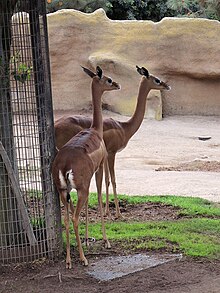Gerenuk
| Gerenuk | |
|---|---|

| |
| Male | |

| |
| Two female gerenuk in the San Diego Zoo | |
| Scientific classification | |
| Domain: | Eukaryota |
| Kingdom: | Animalia |
| Phylum: | Chordata |
| Class: | Mammalia |
| Order: | Artiodactyla |
| Family: | Bovidae |
| Subfamily: | Antilopinae |
| Tribe: | Antilopini |
| Genus: | Litocranius Kohl, 1886 |
| Species: | L. walleri
|
| Binomial name | |
| Litocranius walleri (Brooke, 1879)
| |

| |
| distribution of gerenuk (2008)[2] | |
| Synonyms[3] | |
| |
The gerenuk (
Taxonomy and phylogeny
The gerenuk was first
Two subspecies have been proposed, but these are considered to be independent species by some authors.[3][9][10][11]
- L. w. sclateri (Northern gerenuk or Sclater's gazelle) Neumann, 1899: Its range extends from northwestern Somalia (Berbera District) westward to touch the Ethiopian border and Djibouti.
- L. w. walleri (Southern gerenuk or Waller's gazelle) (Brooke, 1879): Its range extends through northeastern Tanzania through Kenya to Galcaio (Somalia). The range lies north of the Shebelle Riverand near Juba River.
In 1997
Description

The gerenuk is a notably tall, slender
Two types of colouration are clearly visible on the smooth
The gerenuk resembles the
Ecology and behavior
The gerenuk is a diurnal animal (active mainly during the day), though it typically stands or rests in shade during the noon. Foraging and feeding is the major activity throughout the day; females appear to spend longer time in feeding. The gerenuk may expose itself to rain, probably to cool its body.[17] The social structure consists of small herds of two to six members. Herds typically comprise members of a single sex, though female herds additionally have juveniles. Some males lead a solitary life.[10]
Fighting and travel are uncommon, possibly as a strategy to save energy for foraging.[8] Both sexes maintain home ranges 3–6 km2 (1–2+1⁄2 sq mi) large, and might overlap. Those of males are scent-marked with preorbital gland secretions and guarded - hence these may be termed territories. The sedentary tendency of the antelope appears to increase with age.[11]
Diet

Primarily a browser, the gerenuk feed on foliage of bushes as well as trees, shoots, herbs, flowers and fruits.[18] It can reach higher branches and twigs better than other gazelles and antelopes by standing erect on its hindlegs and elongating its neck; this helps it reach over 2 m (6 ft 7 in) above the ground.[11] Acacia species are eaten whenever available,[11] while evergreen vegetation forms the diet during droughts.[14] The pointed mouth assists in extracting leaves from thorny vegetation.[11] The gerenuk does not drink water regularly.[18] Major predators of the antelope include African wild dogs, cheetahs, hyenas, lions and leopards.[10]
Reproduction
Gerenuk reproduce throughout the year. Females reach
References
- . Retrieved 12 November 2021.
- ^ IUCN SSC Antelope Specialist Group (2008). "Litocranius walleri". IUCN Red List of Threatened Species. 2008. Retrieved 21 June 2012.
- ^ OCLC 62265494.
- ^ a b Brooke, V. (1878). "On a new species of gazelle from western Africa". Proceedings of the Zoological Society of London: 929–930.
- ^ Sclater, P.; Thomas, O. (1898). "The gerenuk". The Book of Antelopes. Vol. 3. London: R. H. Porter. pp. 229–237.
- ^ Kohl, F. F. (1886). "Ueber neue und seltene antilopen des K. K. Naturhistorischen Hofmuseums" [About new and rare antelopes from the K. K. Natural History Museum]. Annalen des K.K. Naturhistorisches Hofmuseums (in German). 1 (1): 75–86.
- ^ "gerenuk". Merriam-Webster.com Dictionary. Retrieved 13 May 2020.
- ^ ISBN 9780806131467.
- ISBN 9781421400938.
- ^ ISBN 978-0-691-16717-6.
- ^ ISBN 978-1-4729-1236-7.
- PMID 10381312.
- PMID 23485920.
- ^ ISBN 9780520080850.
- ^ ISBN 978-1-4081-8994-8.
- ^ Leuthold, W. (1978). On the Ecology of the Gerenuk Litocranius walleri. Journal of Animal Ecology, 47(2), 561–580. https://doi.org/10.2307/3801
- .
- ^ JSTOR 3801.
- ^ "One of our member institutions working with assisted reproductive techniques". Conservation Centers for Species Survival. Archived from the original on 2022-02-26. Retrieved 3 June 2013.
Further reading
- Bärmann, Eva V.; Klappert, Ariana N.; Chen, Augustin (2021). "Litocranius walleri (Artiodactyla: Bovidae)". Mammalian Species. 53 (1005): 65–77. .
External links
- Gerenuk at the Encyclopædia Britannica


